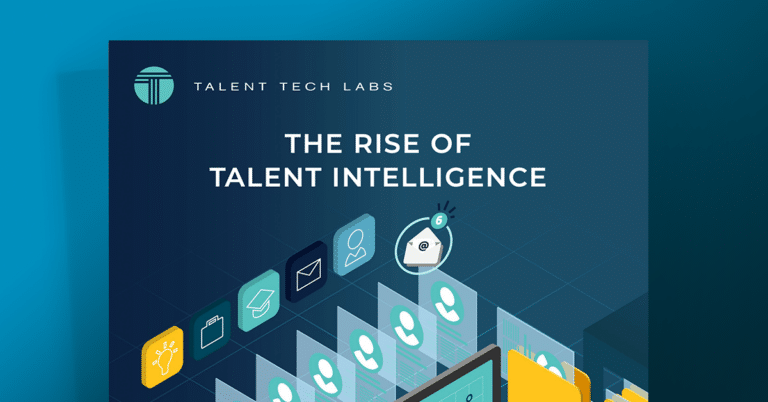
Talent Tech Labs report: The rise of Talent Intelligence
Talent Tech Labs report: The rise of Talent Intelligence
With the use of multiple talent acquisition tools and an omnichannel recruiting strategy approach, today’s recruiting functions are experiencing an overwhelming amount of data from various sources. How are leaders making sense of this data and harnessing it to empower their talent functions? The answer lies in Talent Intelligence.
In this report, you’ll get:
- An understanding of what Talent Intelligence means
- How to leverage Talent Intelligence to make better decisions throughout all phases of the hiring process
- How to piece together data from disparate systems and channels and generate an analysis
THE RISE OF TALENT INTELLIGENCE INTRODUCTION
Hiring has historically been reactive, tactical, and siloed. As companies grow, they need to hire more people. Job requisitions are opened, job posts are posted, and companies then work through a volume of job applications to try and select the individuals that are best qualified and will add the most value to the organization. The mechanisms and processes used to sort and make decisions around talent are bespoke and varied; some companies use assessments, others rely on structured interviews, many use college and years of experience as heuristics, while some have no structured process in place at all.
Over the past couple of years, we have seen the rise of an emerging breed of tools that combine the vast quantities of data that lives in companies’ hiring systems as well as the open web to enable companies to make better strategic decisions around hiring and managing talent. We are calling the solutions in this emerging category “Talent Intelligence.”
We use the term Talent Intelligence to broadly describe the tools and technology platforms that apply AI to the vast quantity of data that lives in companies’ hiring systems, as well as data that lives on the open web, to provide a holistic view of candidates and help clients make better strategic decisions around talent. Some tools are optimized to provide big picture insights, such as which markets have more female software engineers or whether your pay rates are below market (potentially handicapping your talent acquisition efforts), while others give a rich view at the individual talent level, answering questions such as which candidates out of possibly hundreds of applicants are most likely to succeed in a role, or which high-performing internal employees might also be a high potential flight risk.
The earliest examples of Talent Intelligence came from matching technology providers, and our initial thinking around these tools was that Talent Intelligence was something akin to a “Matching 2.0.” That said, we are seeing companies build talent intelligence capabilities across the ecosystem, from LinkedIn via its Talent Insights offering to the Social Search tools and CRM vendors featured in this very report.
We start this quarter’s Trends Report with a case study from HiredScore, an enterprise Matching System, about how they helped Intel increase the number of “decisions per day” by turning disparate data into intelligence. They also share some metrics from across the business which gives some real world sense of the impact these tools are having.
We then hear from Beamery, one of the leading Candidate Relationship Management Systems (CRM) about its efforts and investments to leverage Talent Intelligence in the context of a corporate recruitment marketing automation platform. CRMs are one of the core technologies used to recruit and re-engage passive talent, and given the vast quantity of data and systems integrations these tools possess, Talent Intelligence is a natural area of expansion.
AirAsia is the largest airline in Malaysia and one of the leading airlines in the Asia Pacific region. The company has transformed its business over the course of the pandemic while maintaining its legacy operations. Zuzana Chomistekova, Group Head of Recruiting at AirAsia discusses how AirAsia was able to enter new markets, hire for roles outside its traditional centers of excellence, and continues to innovate while driving operational efficiencies in the core business leveraging Eightfold.ai’s Talent Intelligence capabilities.
Next, we hear from the founder of Hiretual, a tool that has mapped more than 750 million candidate profiles globally, about the building blocks and implications of talent data systems, and how to architect an ideal recruitment infrastructure.
Finally, we end our exploration of the space with an article from Ideal, a matching platform, about the validated use cases and impact of Talent Intelligence tools.
You might also like...
Get the latest talent news in your inbox every month
By submitting this form, I consent to Eightfold processing my personal data in accordance with its Privacy Notice and agree to receive marketing emails from Eightfold about its products and events. I acknowledge that I can unsubscribe or update my preferences at any time.
